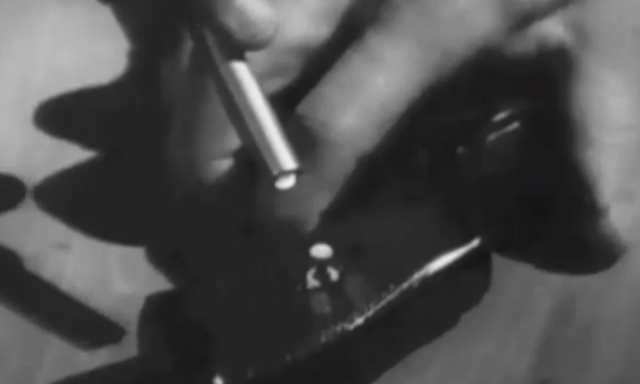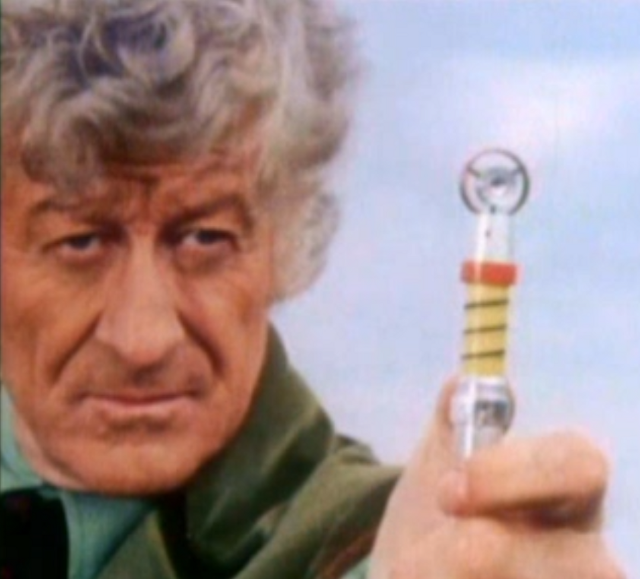This article is more than 1 year old
Build your own WORKING Sonic Screwdriver... for a UNDER A FIVER
Our man embarks on the ULTIMATE maker project for fans
Doctor Who @ 50 The Doctor’s sonic screwdriver has become steadily more iconic as the years progressed. Despite disappearing in the middle of the Time Lord’s career, it’s now firmly – not to say commercially – integrated into the Doctor Who canon. So there’s no more to say on the subject, right?
Wrong.
Earlier this year, the Sonic Screwdriver came up during an editorial meeting at Vulture Towers. The discussion quickly turned into a debate about whether the screwdriver was a clever aspect of the character or merely a deus ex machina for writers who didn’t want to be distracted by plot mechanics when they could be penning soul-searching soliloquies or homoerotic banter.
We also wondered how you could possible make one of your own. We can’t look into the minds of modern Who writers, but we can have a go at making a sonic screwdriver for ourselves. Here’s how it worked out.

No human would turn a screw like that
Source: BBC
The real Sonic Screwdriver didn’t even turn up until the second Doctor, who generally used it to prove how alien he was. Unlike a regular screwdriver which removes screws by physically rotating them, the “sonic” screwdriver removes them without physical contact - clearly a huge advance and, more importantly to the plot, incontestable proof that the character so notably played by Patrick Troughton, wasn’t a human.
There are, according to official sources, nine different models of Sonic Screwdriver, and a handful of similar devices (mainly) wielded by characters from well-equipped futures.
Fan Will Marler has created a particularly beautiful rendition of the whole range. But the casual fan will probably only recognise four distinct models, with perhaps the most well-known being the stick-with-a-red-circle-on-top as used by John Pertwee. Pertwee, of course, lacked gadgets having been stranded on Earth for budgetary reasons. Tom Baker got to use it too and so, briefly, did Peter Davison.
Making something to rotate things from a distance, even screws, is probably beyond the El Reg budget but straying comfortably into DARPA territory. The third Doctor’s reference to his electronic “door handle”, used in the 1970 story Inferno helps little, though it does point us towards a possible get-out clause for our project.

Pretty colours were all the rage in the 1970s
Source: BBC
The Sonic Screwdriver isn’t just used to disable Daleks and summon the Tardis when the plot demands, it also provides comic relief by lighting candles and opening the occasional bottle of champagne, and works as a display showing information which would be too complicated to relate on the television screen - sharing that facility with Star Trek’s Tricorder. So we don’t need to create something dramatic to replicate its function, if not its form.
A blow-torch was tempting, and would replicate some of the capabilities demonstrated by the increasingly versatile original. A pocket blow-torch can light candles, melt plastic and cut rope and (at a push) metal, but making one from scratch is tough. In any case, existing devices bear an uncanny similarity to a steampunk Sonic Screwdriver already.
But it’s “detecting mysterious forces” where the Doctor’s screwdriver really comes to the aid of the lazy writer. Eddies in the space-time continuum, psychic energy or traces of mutated DNA might be beyond our grasp but there is the marvelously simple “Ridiculously Sensitive Electric Charge Detector”, a circuit which requires only three components – two of which don’t need to be accurately specified. This is our kind of electronics project.

This is my kind of circuit
The design calls for a 9V battery, but happily runs off 3V. This was important: shoehorning a box-type battery into the shape of a Sonic Screwdriver would challenge even the designers of the Tardis. The light goes out when static electricity is nearby, such as a recently used comb or plastic rod. As it stands the range is only a few centimetres, but extend the antenna and the sensitivity increases. The designer reckons a 50cm antenna will spot someone brushing their hair 5m away - an ability worthy of any Time Lord, surely?
That circuit will detect mysterious forces - and if you don’t consider electromagnetism to be mysterious then you’re either way too cynical or Stephen Hawking - but it was almost too simple, so I decided to add a touch control. Now my Sonic Screwdriver would be controlled with a gentle caress rather than a sliding switch or button. After the minimum of searching, HobbyTronics turned up an IC which would meet our requirements for a couple of quid. Given my soldering skills, I ordered three and slapped one onto the breadboard.

The Touch IC is suprisingly robust too, coping with repeatedly-wrong connections
The touch circuit also runs happily on 3V, which was a relief. Connected to a bench supply it triggers too easily (when a wire is connected) but once hooked up tp a couple of AA batteries it works perfectly. So much so that I decided to keep the red LED used for testing as a confidence light (so the user knows when the screwdriver is on) and as a diagnostic (so I know when our wiring has failed).
Now we have a circuit which responds to a touch and detects mysterious forces, but it doesn’t yet look the part.
